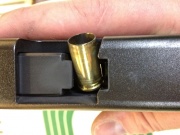Firearm malfunction

Where's the rest?? This article is incomplete!
You (yes, you!) can help Gunsopedia provide more comprehensive information to our users by using your own knowledge to add to it.
|
A firearm malfunction (also misfire and jam) is the partial or complete failure of a firearm to operate as intended. Malfunctions range from temporary and relatively safe situations, such as a casing that didn't eject, to potentially dangerous occurrences that may permanently damage the gun and cause injury or death. Malfunctions are sometimes considered a factor in negligent discharge. Proper cleaning and maintenance of a firearm play a big role in preventing malfunctions.
[edit] Cartridge malfunctions
The malfunction of a cartridge (commonly called a misfire) is the failure of the primer and/or powder within a cartridge to function as expected.
[edit] Case head separation
Case head separation occurs when the walls of the casing become thin or fatigued. Upon firing the round, the case separates into two pieces near the head. It is not uncommon with brass that has been reloaded several times.
[edit] Dud
- Main article: Dud
A dud (also failure to discharge) occurs when the trigger is pulled but the primer or powder in the cartridge malfunctions, causing the firearm to not discharge. Dud rounds can still be dangerous and should be deactivated and disposed of properly.
[edit] Hang fire
- Main article: Hang fire
A hang fire (also delayed discharge) is an unexpected delay between the triggering of a firearm and the ignition of the propellant. Whenever a weapon fails to fire, but has not clearly malfunctioned, a hang fire should be suspected. When this occurs, the correct procedure is to keep the weapon pointed downrange or in a safe direction for thirty to sixty seconds, then remove and safely discard the round. The reason for this is that a round detonating outside of the weapon, or in the weapon with the action open, could cause serious fragmentation injury.
[edit] Squib load
- Main article: Squib load
A squib load (also squib round, squib, squib fire, insufficient discharge, incomplete discharge) is an extremely dangerous malfunction that happens when a fired projectile does not carry enough force and becomes stuck in the gun barrel instead of exiting it. In the case of semi-automatic or automatic weapons, this can cause successive rounds to be fired into the projectile obstructing the barrel, which can cause catastrophic failure to the structural integrity of the firearm, and pose a threat to the operator or bystanders. The bullet from a squib stuck in the barrel can be ejected when subsequently firing a blank round, causing the gun to discharge a bullet when not expected. Furthermore, blank rounds use a type of powder different from that of other rounds, and generate much more pressure. Therefore, the presence of a bullet or other obstruction in the barrel may cause the firearm to explode.
[edit] Mechanical malfunctions
Mechanical malfunctions of a firearm (commonly called jams) include failures to feed, extract, or eject a cartridge; failure to fully cycle after firing; and failure of a recoil- or gas-operated firearm to lock back when empty (largely a procedural hazard, as "slide lock" is a visual cue that the firearm is empty). In extreme cases, an overloaded round, blocked barrel, poor design and/or severely weakened breech can result in an explosive failure of the receiver, barrel, or other parts of the firearm.
[edit] Failure to feed
Failure to Feed (FTF) is when a weapon fails to feed the next round into the firing chamber.
[edit] Hammer follow
Hammer follow occurs when the disconnector allows the hammer to follow the bolt and firing pin into battery sometimes causing the firing mechanism to function faster than it is designed to.
[edit] Slamfire
- Main article: Slamfire
A slamfire is a premature, unintended discharge of a firearm that occurs as a round is being loaded into the chamber.
[edit] Stovepipe
A stovepipe, smokestack, or failure to eject (FTE) occurs when the empty cartridge case jams vertically in the ejection port of a self-loading firearm instead of being thrown clear, a condition usually caused by not holding the firearm correctly, or "limp wristing".[edit] Ramifications
Firearm malfunctions can cause death or injury.
Courts have held, as they did in the case of David Olofson, that when a worn firearm malfunctions in such a way as to fire multiple cartridges one or more times, this makes it a machine gun, causing legal liability for the owner.[1]
[edit] Prevention
Some mechanical malfunctions are caused by poor design and cannot easily be avoided. Some malfunctions with cartridges can be attributed to poor quality or damaged (improper storage, moisture) ammunition. Many malfunctions can be prevented by properly practicing firearm cleaning and maintenance on a regular basis.
[edit] See also
[edit] References
- ↑ "Lou Dobbs Tonight - Transcript". CNN. 2009-01-22. Retrieved 2011-01-19. "Olofson is now in federal prison convicted of illegally transferring a machine gun"
